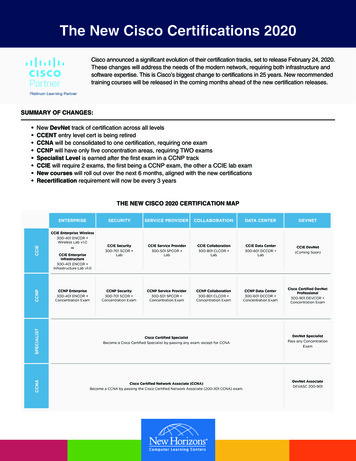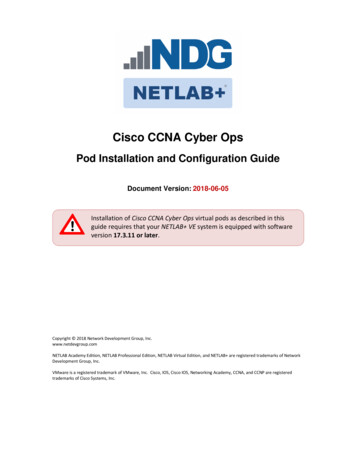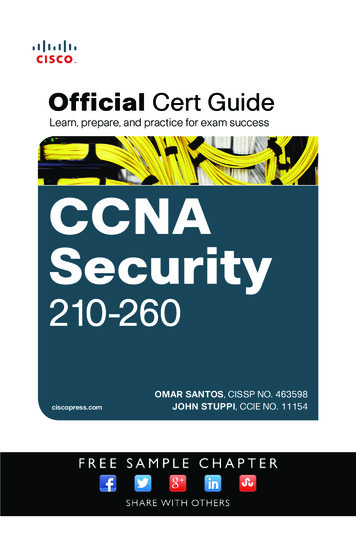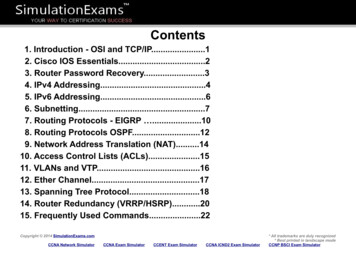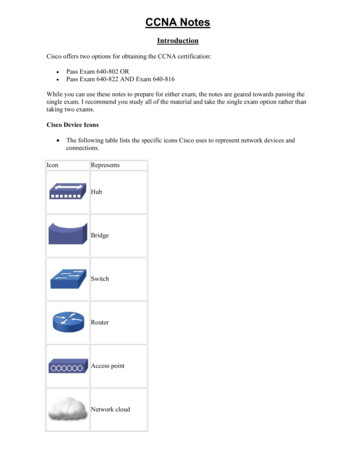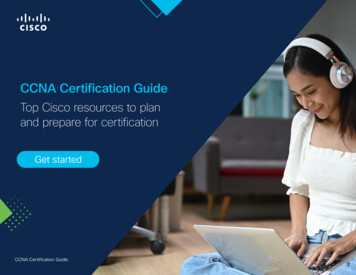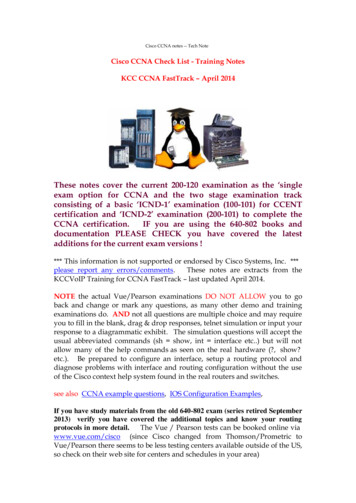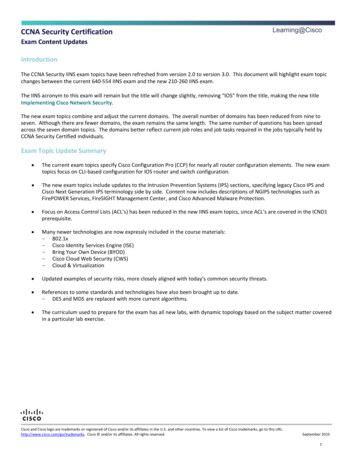
Transcription
ExInatmrCodonucttieontUpdatesnThe CCNA Security IINS exam topics have been refreshed from version 2.0 to version 3.0. This document will highlight exam topicchanges between the current 640-554 IINS exam and the new 210-260 IINS exam.The IINS acronym to this exam will remain but the title will change slightly, removing “IOS” from the title, making the new title.ImplementingCiscoNetworkSecurityThe new exam topics combine and adjust the current domains. The overall number of domains has been reduced from nine toseven. Although there are fewer domains, the exam remains the same length. The same number of questions has been spreadacross the seven domain topics. The domains better reflect current job roles and job tasks required in the jobs typically held byCCNA Security Certified individuals.ExamTopicUpdateSummary The current exam topics specify Cisco Configuration Pro (CCP) for nearly all router configuration elements. The new examtopics focus on CLI-based configuration for IOS router and switch configuration. The new exam topics include updates to the Intrusion Prevention Systems (IPS) sections, specifying legacy Cisco IPS andCisco Next Generation IPS terminology side by side. Content now includes descriptions of NGIPS technologies such asFirePOWER Services, FireSIGHT Management Center, and Cisco Advanced Malware Protection. Focus on Access Control Lists (ACL’s) has been reduced in the new IINS exam topics, since ACL’s are covered in the ICND1prerequisite. Many newer technologies are now expressly included in the course materials:- 802.1x- Cisco Identity Services Engine (ISE)- Bring Your Own Device (BYOD)- Cisco Cloud Web Security (CWS)- Cloud & Virtualization Updated examples of security risks, more closely aligned with today’s common security threats. References to some standards and technologies have also been brought up to date.- DES and MD5 are replaced with more current algorithms. The curriculum used to prepare for the exam has all new labs, with dynamic topology based on the subject matter coveredin a particular lab exercise.Cisco and Cisco logo are trademarks or registered of Cisco and/or its affiliates in the U.S. and other countries. To view a list of Cisco trademarks, go to this URL:http://www.cisco.com/go/trademarks. Cisco and/or its affiliates. All rights reserved.September 20151
ExamContentUpdatesFigure 1: Current Exam Topics versus New Exam TopicsDetailedExamTopicComparisonA detailed comparison of the current 640-554 IINS exam and the new 210-260 IINS exam is shown below.640-554: Implementing Cisco IOS Network Security11% 1.0 Common Security Threats1.1 Describe common security threats1.1.a Common threats to the physical installation1.1.b Mitigation methods for common network attacks1.1.c Email-based threats1.1.d Web-based attacks1.1.e Mitigation methods for Worm, Virus, and Trojan Horseattacks1.1.f Phases of a secure network lifecycle1.1.g Security needs of a typical enterprise with acomprehensive security policy1.1.h Mobile/remote security1.1.i DLP (Data Loss Prevention)8% 2.0 Security and Cisco Routers2.1Implement security on Cisco routers2.1.a CCP Security Audit feature2.1.b CCP One-Step Lockdown feature2.1.c Secure router access using strong encrypted passwords,and using IOS login enhancements, IPV6 security2.1.d Multiple privilege levels2.1.e Role-based CLI2.1.f Cisco IOS image and configuration files2.2 Describe securing the control, data and management plane2.3 Describe CSM2.4 Describe IPv4 to IPv6 transition2.4.a Reasons for IPv62.4.b Understanding IPv6 addressing2.4.c Assigning IPv6 addresses2.4.d Routing considerations for IPv6210-260: Implementing Cisco Network Security12% 1.0 Security Concepts1.1 Common Security Principles1.1.a Describe Confidentiality, Integrity, Availability (CIA)1.1.b Describe SIEM technology1.1.c Identify common security terms1.1.d Identify common network security zones1.2 Common Security Threats1.2.a Identify Common network attacks1.2.b Describe Social Engineering1.2.c Identify Malware1.2.d Classify the vectors of Data Loss/Exfiltration1.3 Cryptography Concepts1.3.a Describe Key Exchange1.3.b Describe Hash Algorithm1.3.c Compare & Contrast Symmetric andAsymmetric Encryption1.3.d Describe Digital Signatures, Certificates and PKI1.4 Describe network topologies1.4.a Campus Area Network (CAN)1.4.b Cloud, Wide Area Network (WAN)1.4.c Data Center1.4.d Small office/Home office (SOHO)1.4.e Network security for a virtual environment14% 2.0 Secure Access2.1 Secure management2.1.a Compare In-band and out of band2.1.b Configure secure network management2.1.c Configure and verify secure access throughSNMP v3 using an ACL2.1.d Configure and verify security for NTPCisco and Cisco logo are trademarks or registered of Cisco and/or its affiliates in the U.S. and other countries. To view a list of Cisco trademarks, go to this URL:http://www.cisco.com/go/trademarks. Cisco and/or its affiliates. All rights reserved.September 20152
ExamContentUpdates11% 3.0 AAA on Cisco Devices3.1Implement authentication, authorization,and accounting (AAA)8.1.a AAA using CCP on routers8.1.b AAA using CLI on routers and switches8.1.c AAA on ASA3.2 Describe TACACS 3.3 Describe RADIUS3.4 Describe AAA3.4.a Authentication3.4.b Authorization3.4.c Accounting3.5 Verify AAA functionality.12% 4.0 IOS ACLs4.1 Describe standard, extended, and named IP IOS ACLsto filter packets4.1.a IPv44.1.b IPv64.1.c Object groups4.1.d ACL operations4.1.e Types of ACLs (dynamic, reflexive, time-based ACLs)4.1.f ACL wild card masking4.1.g Standard ACLs4.1.h Extended ACLs4.1.i Named ACLs4.1.j VLSM4.2 Describe considerations when building ACLs4.2.a Sequencing of ACEs4.2.b Modification of ACEs4.3 Implement IP ACLs to mitigate threats in a network4.3.a Filter IP traffic4.3.b SNMP4.3.c DDoS attacks4.3.d CLI4.3.e CCP4.3.f IP ACLs to prevent IP spoofing4.3.g VACLs10% 5.0 Secure Network Management and Reporting5.1Describe secure network management5.1.a In-band5.1.b Out of band5.1.c Management protocols5.1.d Management enclave5.1.e Management plane5.2 Implement secure network management5.2.a SSH5.2.b syslog5.2.c SNMP5.2.d NTP5.2.e SCP5.2.f CLI5.2.g CCP5.2.h SSL2.1.e Use SCP for file transfer2.2 AAA Concepts2.2.a Describe RADIUS & TACACS technologies2.2.b Configure administrative access on a Cisco routerusing TACACS 2.2.c Verify connectivity on a Cisco router to a TACACS server2.2.d Explain the integration of Active Directory with AAA2.2.e Describe Authentication & Authorization using ACSand ISE2.3 802.1x Authentication2.3.a Identify the functions 802.1x components2.4 BYOD (Bring-Your-Own-Device)2.4.a Describe the BYOD architecture framework2.4.b Describe the function of Mobile Device Management(MDM)17% 3.0 Virtual Private Networks (VPN)3.1 VPN Concepts3.1.a Describe IPSec Protocols and Delivery Modes(IKE, ESP, AH, Tunnel mode, Transport mode)3.1.b Describe Hairpinning, Split Tunneling, Always-on,NAT Traversal3.2 Remote Access VPN3.2.a Implement basic Clientless SSL VPN using ASDM3.2.b Verify clientless connection3.2.c Implement basic AnyConnect SSL VPN using ASDM3.2.d Verify AnyConnect connection3.2.e Identify Endpoint Posture Assessment3.3 Site-to-Site VPN3.3.a Implement an IPSec site-to-site VPN with pre-shared keyauthentication on Cisco routers and ASA firewalls3.3.b Verify an IPSec site-to-site VPN18% 4.0 Secure Routing and Switching4.1 Security on Cisco Routers4.1.a Configure multiple privilege levels4.1.b Configure IOS Role-based CLI Access4.1.c Implement IOS Resilient Configuration4.2 Securing Routing Protocols4.2.a Implement routing update authentication on OSPF4.3 Securing the Control Plane4.3.a Explain the function of Control Plane Policing4.4 Common Layer 2 Attacks4.4.a Describe STP attacks4.4.b Describe ARP Spoofing4.4.c Describe MAC spoofing4.4.d Describe CAM Table (MAC Address Table) Overflows4.4.e Describe CDP/LLDP Reconnaissance4.4.f Describe VLAN Hopping4.4.g Describe DHCP Spoofing4.5 Mitigation Procedures4.5.a Implement DHCP Snooping4.5.b Implement Dynamic ARP Inspection4.5.c Implement Port Security4.5.d Describe BPDU Guard, Root Guard, Loop Guard4.5.e Verify mitigation procedures4.6 VLAN Security4.6.a Describe the security implications of a PVLAN4.6.b Describe the security implications of a Native VLANCisco and Cisco logo are trademarks or registered of Cisco and/or its affiliates in the U.S. and other countries. To view a list of Cisco trademarks, go to this URL:http://www.cisco.com/go/trademarks. Cisco and/or its affiliates. All rights reserved.September 20153
ExamContentUpdates12% 6.0 Common Layer 2 Attacks6.1 Describe Layer 2 security using Cisco switches6.1.a STP attacks6.1.b ARP spoofing6.1.c MAC spoofing6.1.d CAM overflows6.1.e CDP/LLDP6.2 Describe VLAN Security6.2.a Voice VLAN6.2.b PVLAN6.2.c VLAN hopping6.2.d Native VLAN6.3 Implement VLANs and Trunking6.3.a VLAN definition6.3.b Grouping functions into VLANs6.3.c Considering traffic source to destination paths6.3.d Trunking6.3.e Native VLAN6.3.f VLAN trunking protocols6.3.g Inter-VLAN routing6.4 Implement Spanning Tree6.4.a Potential issues with redundant switch topologies6.4.b STP operations6.4.c Resolving issues with STP13% 7.0 Cisco Firewall Technologies7.1 Describe operational strengths and weaknessesof the different firewall technologies7.1.a Proxy firewalls7.1.b Packet and stateful packet7.1.c Application firewall7.1.d Personal firewall7.2 Describe stateful firewalls7.2.a Operations7.2.b Function of the state table7.3 Describe the types of NAT used in firewall technologies7.3.a Static7.3.b Dynamic7.3.c PAT7.4 Implement Zone Based Firewall using CCP7.4.a Zone to zone7.4.b Self zone7.5 Implement the Cisco Adaptive Security Appliance (ASA)7.5.a NAT7.5.b ACL7.5.c Default MPF7.5.d Cisco ASA sec level7.6 Implement NAT and PAT7.6.a Functions of NAT, PAT, and NAT Overload7.6.b Translating inside source addresses7.6.c Overloading Inside global addresses18% 5.0 Cisco Firewall Technologies5.1 Describe operational strengths and weaknessesof the different firewall technologies5.1.a Proxy firewalls5.1.b Application firewall5.1.c Personal firewall5.2 Compare Stateful vs. Stateless Firewalls5.2.a Operations5.2.b Function of the state table5.3 Implement NAT on Cisco ASA 9.x5.3.a Static5.3.b Dynamic5.3.c PAT5.3.d Policy NAT5.3 e Verify NAT operations5.4 Implement Zone Based Firewall5.4.a Zone to zone5.4.b Self zone5.5 Firewall features on the Cisco Adaptive Security Appliance(ASA) 9.x5.5.a Configure ASA Access Management5.5.b Configure Security Access Policies5.5.c Configure Cisco ASA interface security levels5.5.d Configure Default Modular Policy Framework (MPF)5.5.e Describe Modes of deployment(Routed firewall, Transparent firewall)5.5.f Describe methods of implementing High Availability5.5.g Describe Security contexts5.5.h Describe Firewall Services9% 6.0 Intrusion Prevention Systems (IPS)6.1 Describe IPS Deployment Considerations6.1.a Network Based IPS vs. Host Based IPS6.1.b Modes of deployment (Inline, Promiscuous - SPAN, tap)6.1.c Placement (positioning of the IPS within the network)6.1.d False Positives, False Negatives, True Positives,True Negatives6.2 Describe IPS Technologies6.2.a Rules/Signatures6.2.b Detection/Signature Engines6.2.c Trigger Actions/Responses (drop, reset, block,alert, monitor/log, shun)6.2.d Blacklist (Static & Dynamic)12% 7.0 Content and Endpoint Security7.1 Describe Mitigation Technology for Email-based Threats7.1.a SPAM Filtering, Anti-Malware Filtering, DLP, Blacklisting,Email Encryption7.2 Describe Mitigation Technology for Web-based Threats7.2.a Local & Cloud Based Web Proxies7.2.b Blacklisting, URL-Filtering, Malware Scanning,Cisco and Cisco logo are trademarks or registered of Cisco and/or its affiliates in the U.S. and other countries. To view a list of Cisco trademarks, go to this URL:http://www.cisco.com/go/trademarks. Cisco and/or its affiliates. All rights reserved.September 20154
ExamContentUpdates11% 8.0 Cisco IPS8.1 Describe IPS deployment considerations8.1.a SPAN8.1.b IPS product portfolio8.1.c Placement8.1.d Caveats8.2 Describe IPS technologies8.2.a Attack responses8.2.b Monitoring options8.2.c syslog8.2.d SDEE8.2.e Signature engines8.2.f Signatures8.2.g Global correlation and SIO8.2.h Network-based8.2.i Host-based8.3 Configure Cisco IOS IPS using CC8.3.a Logging8.3.b SignaturesURL Categorization, Web Application Filtering,TLS/SSL Decryption7.3 Describe Mitigation Technology for Endpoint Threats7.3.a Anti-Virus/Anti-Malware7.3.b Personal Firewall/HIPS7.3.c Hardware/Software Encryption of local data12% 9.0 VPN Technologies9.1 Describe the different methods used in cryptography9.1.a Symmetric9.1.b Asymetric9.1.c HMAC9.1.d Message digest9.1.e PKI9.2 Describe VPN technologies9.2.a IPsec9.2.b SSL9.3 Describe the building blocks of IPSec9.3.a IKE9.3.b ESP9.3.c AH9.3.d Tunnel mode9.3.e Transport mode9.4 Implement an IOS IPSec site-to-site VPN with pre-shared keyauthentication9.4.a CCP9.4.b CLI9.5 Verify VPN operations.9.6 Implement SSL VPN using ASA device manager9.6.a Clientless9.6.b AnyConnectLearnMoreGet more information on the Cisco CCNA Security certification and available security training.Cisco and Cisco logo are trademarks or registered of Cisco and/or its affiliates in the U.S. and other countries. To view a list of Cisco trademarks, go to this URL:http://www.cisco.com/go/trademarks. Cisco and/or its affiliates. All rights reserved.September 20155
The CCNA Security IINS exam topics have been refreshed from version 2.0 to version 3.0. This document will highlight exam topic changes between the current 640-554 IINS exam and the new 210-260 IINS exam. The IINS acronym to this exam will remain but the title will change slig
